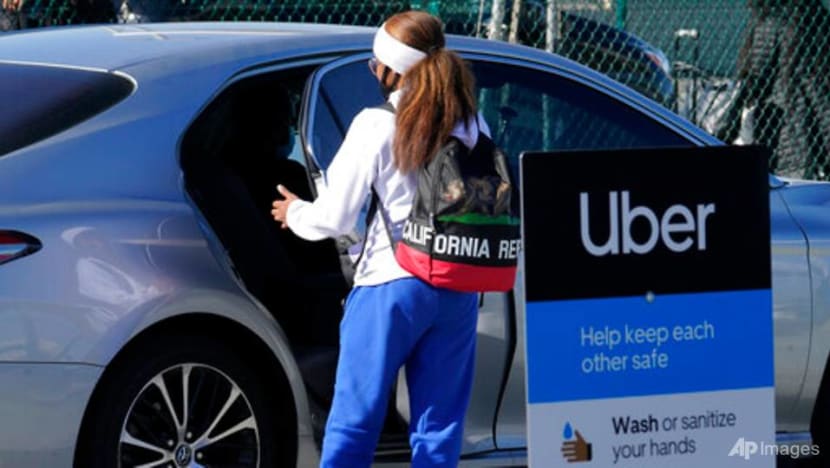Uber demand jumps as delivery grows, ride-hailing recovers

In this Nov. 13, 2020 file photo, a traveller rides in the back of an Uber vehicle at Los Angeles International Airport in Los Angeles. (Photo: AP/Damian Dovarganes)
NEW YORK: Uber Technologies said on Wednesday (May 5) its food-delivery business continued to grow despite gradual signs of US recovery from the COVID-19 pandemic, but ride-hail bookings were flat from the previous quarter.
But the ride-hailing mobility business had to absorb a US$600 million hit to account for a settlement with its more than 70,000 UK drivers and provide them with more benefits.
Shares ticked up 0.3 per cent in after-hours trading after falling 3.7 per cent during the regular session.
Uber posted an adjusted US$359 million first-quarter loss before interest, taxes, depreciation and amortisation - a metric that excludes one-time costs, including stock-based compensation, narrowing losses by nearly US$100 million from the previous quarter.
Analysts on average had expected the company to report an adjusted EBITDA loss of around US$452 million, Refinitiv data showed.
Uber has promised to be profitable on that metric by the end of the year, three months after its smaller ride-hail rival Lyft which on Tuesday said it would report sustained adjusted profits starting in the third quarter.
Revenue at Uber's delivery segment, which includes its Uber Eats restaurant delivery business, more than tripled from last year and grew 28 per cent from last quarter to US$1.7 billion.
Some analysts have questioned whether the delivery boom would last once customers were no longer homebound and businesses and restaurants reopened.
But Uber in the past said it expected many of its Uber Eats customers to remain loyal and in an investor presentation on Wednesday showed delivery booking in Sydney and New York increased even as those cities were reopening.
"The delivery category is completely underpenetrated," said Forrester analyst James McQuivey, adding that many people who tried food delivery for the first time during the pandemic will keep ordering.
Uber's ride-hail gross bookings, which plummeted over the last year due to the pandemic, remained roughly flat from the last quarter and down 38% from the previous year.
The US$600 million UK charge is a sign of the costs the company could face if it were to provide similar benefits to US drivers, a measure it is pushing for with US regulators to avoid even costlier regulation that would turn gig workers into employees.
Uber on Wednesday said it had 3.5 million active drivers and food-delivery workers on its platform during the first quarter, the majority of whom work in the United States.
Uber's first-quarter results come on the heels of the company's announcement last month that March had been the best month in its nearly 12-year history, with its mobility business reporting the most bookings since the start of the pandemic and delivery demand outstripping driver supply.
The recovery is mainly driven by Uber's North American business, where higher COVID-19 vaccination rates and a loosening of government restrictions are prompting many people to return to pre-pandemic activities.
SLASHING COSTS
Both Uber and Lyft have struggled to serve the spring rebound in ride-hail trips, as consumer demand temporarily outstrips driver supply, leading to higher prices and longer wait times in some US cities. Uber in April said it would invest an additional US$250 million to further boost driver earnings and offer payment guarantees in an effort to incentivise new and existing drivers.
Excluding the US$600 million charge, Uber reported US$3.5 billion in first-quarter revenue, ahead of an average analyst estimate for US$3.29 billion, according to Refinitiv data.
Uber has drastically slashed costs over the last months to reach its year-end profitability targets and sold off adjacent businesses, including its self-driving technology unit.
The company has slashed more than US$5.7 billion in total costs since the beginning of last year.
But Uber and its gig-economy peers also face growing regulatory pressure from a new administration under US President Joe Biden, who campaigned on the promise of delivering benefits to gig workers by turning them into employees.
Uber and Lyft's shares took a tumble last week when US Labor Secretary Marty Walsh told Reuters in an interview that "a lot of gig workers should be classified as employees".
The gig companies rely on low-cost flexible workers and say their services would become unavailable if workers were reclassified as employees. They say surveys show the majority of their workers do not want to be employees and instead propose a compromise that would maintain workers' status as independent contractors, but offer them some benefits.










